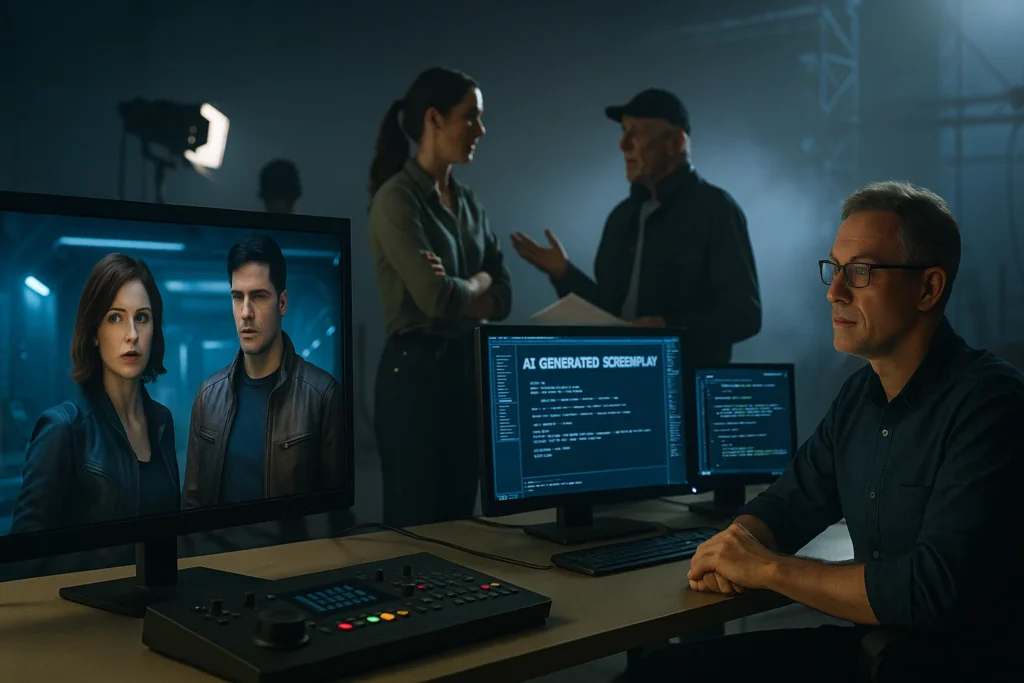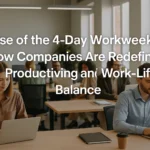Introduction: The New Face of Filmmaking
For over a century, Hollywood has captivated audiences with stories crafted by human minds, brought to life by human actors. The magic of cinema has always been rooted in that uniquely human connection. But in 2025, a powerful new force is sweeping through the industry: Artificial Intelligence. Studios are no longer just dreaming about AI; they’re actively using generative AI to write scripts, create realistic characters, and even generate entire performances that blur the line between real and digital.
This new era is sparking a furious debate, shaking the very foundations of the entertainment world. On one side, there’s excitement about endless creative possibilities and unheard-of efficiencies. On the other, there’s deep concern from unions, creators, and even audiences about job losses, intellectual property, and what truly defines storytelling in the age of artificial creativity. The iconic dream factory of Hollywood is now grappling with its most complex production yet: how to navigate a future where machines might become the next big stars.
Studios Embrace the Algorithm: AI as a Creative Partner
Major studios, constantly seeking innovation and efficiency, are quickly jumping on the AI bandwagon. They see generative AI as a powerful new tool, not just for behind-the-scenes tasks, but for directly contributing to the creative process of filmmaking.
From Concept to Screen: AI’s New Role
Imagine a screenwriter struggling with a plot twist, or a director needing an extra shot but lacking the budget. This is where AI is stepping in. Companies like Netflix and Warner Bros. are now exploring and implementing AI in various stages of content creation:
- Co-writing Scripts: Generative AI models are being used to assist writers, acting almost like a super-powered research assistant or a brainstorming partner. These AIs can suggest plot points, generate dialogue in specific character voices, or even create entire scene outlines based on a brief description. While a human writer still guides the narrative, the AI speeds up the initial phases, helping overcome writer’s block or explore numerous story variations much faster.
- Generating Deepfake Performances: This is where things get truly futuristic—and controversial. Studios are using AI to create “deepfake” performances, where a digital version of an actor (either existing or entirely synthetic) can be animated to deliver lines or perform actions without the human actor ever stepping on set. This could involve de-aging actors for flashbacks, creating impossible stunts, or even conjuring entirely new digital characters that look incredibly lifelike.
- Automating Pre-Production: Beyond direct creative input, AI is streamlining much of the early film development. It can analyze thousands of existing scripts to predict potential success, identify plot holes, or even suggest ideal casting based on market appeal. Lionsgate, for instance, has partnered with AI companies to create custom models that help generate cinematic videos and streamline production processes, aiming for more “capital-efficient” content.
- Post-Production Efficiency: AI also plays a growing role after filming. It can quickly generate special effects, create detailed storyboards from script inputs, automate tasks like dubbing with natural lip movements, and even compose music and sound effects, speeding up the complex and costly post-production phase.
The appeal for studios is clear: reduced costs, faster production times, and the ability to create visual spectacles that might otherwise be impossible. AI promises to be the ultimate creative assistant, pushing the boundaries of what’s achievable in filmmaking.
The Pushback: Job Losses and the Threat to Creativity
While studios embrace AI with enthusiasm, the human backbone of Hollywood—its writers, actors, and artists—are sounding the alarm. For them, the rise of AI isn’t just about cool technology; it’s a direct threat to their livelihoods, their creative control, and the very essence of human artistry.
A Battle for Human Artistry
- Voice Actors’ Fears: Imagine spending years honing your voice for narration, animation, or commercials, only for a studio to create a digital replica of your voice that can perform endlessly without further pay. Voice actors, often the first line of defense against automated performances, are particularly vulnerable to job losses. They fear that their voices could be “scanned” and then used by AI to generate new dialogue indefinitely, bypassing the need for human talent.
- Writers’ Woes: The idea of AI co-writing scripts, while seemingly helpful, directly impacts the value of a human writer’s work. Writers worry that studios will rely on AI for first drafts, significantly reducing the number of writing jobs, or pushing down pay for human writers who are then relegated to “editing” machine-generated content. They argue that AI can mimic style but lacks true originality, empathy, or the lived experiences that give stories their soul.
- Intellectual Property Theft: A major concern revolves around intellectual property (IP) theft. AI models learn by ingesting vast amounts of existing content – scripts, books, images, and performances. Creators argue that training AI on their copyrighted work without consent or fair compensation is a form of theft. If an AI can then generate new content that sounds suspiciously like a human’s unique style or voice, how can creators protect their original work? This issue raises complex legal questions about ownership and fair use in the age of machine learning.
- The Devaluation of Art: Beyond direct job impacts, many artists feel that an overreliance on AI devalues human creativity. If a film can be pieced together by algorithms, does it diminish the emotional impact of a human artist’s struggle, passion, and vision? This philosophical debate runs deep, touching upon the very purpose of art.
The pushback from creators isn’t just about protecting jobs; it’s about preserving the human element at the heart of storytelling, ensuring that technology serves art, rather than replaces it.
The Union Fight: Drawing Lines in the Digital Sand
The concerns of actors and writers haven’t just been voiced in public forums; they’ve been taken to the negotiating table. Hollywood’s powerful unions, SAG-AFTRA (Screen Actors Guild – American Federation of Television and Radio Artists) and the WGA (Writers Guild of America), have1 made regulating AI use a central, non-negotiable demand in their recent contract negotiations.
Protecting Performers and Pens
- SAG-AFTRA’s Demands: The actors’ union, SAG-AFTRA, led significant strikes in 2023, with AI being a key sticking point. Their main goal is to prevent studios from scanning an actor’s likeness (their face, body, and voice) and then using that digital replica for new projects without proper consent, fair compensation, and clear boundaries. The union demanded and secured new contract clauses in their 2025 Commercials Contract, for instance, specifically addressing “Digital Replicas and Synthetic Performers.” These clauses now require:
- Consent: Explicit permission from the actor for their likeness to be used by AI.
- Notice: Clear information about how and where their digital likeness will be used.
- Premium Pay: Additional compensation for the use of their digital replica, ensuring actors benefit financially from the longevity of their digital selves. The goal is to ensure that a digital performance is treated similarly to a physical one, protecting actors from endless, uncompensated re-use of their digital image.
- WGA’s Demands: The Writers Guild of America also went on strike in 2023, largely over AI. Their core demands focused on ensuring that AI cannot be used to write scripts or source material without human writers being properly credited and compensated. They pushed for clauses that:
- Prohibit AI from being credited as a writer: Maintaining that only human writers can be deemed authors.
- Regulate AI’s use in the writing process: Ensuring AI is a tool, not a replacement, for human writers.
- Establish minimum human involvement: Guarantees that projects still require a substantial human creative input.
- Protect copyrighted material: Preventing AI from being trained on WGA members’ work without permission or compensation. These union efforts are crucial for shaping the legal and ethical framework for AI in entertainment, attempting to balance technological progress with the protection of human creative livelihoods.
These contract battles highlight a critical shift: the future of Hollywood isn’t just about what technology can do, but what it should do, with unions fighting to draw clear lines in the digital sand.
AI Artistry: Awards and the Blurring Lines
Beyond the heated debates and union demands, AI-created content is quietly, and sometimes loudly, making its mark in the artistic world. In 2025, AI-created films are already winning awards at indie festivals, signaling a powerful shift and blurring the line between human and machine-made art.
From Code to Canvas, to Cinema
- Festival Recognition: Film festivals dedicated to AI-generated content, like the AI Film Festival (AIFF 2025), are gaining traction. These platforms showcase short films where AI has played a significant role, from generating visuals and character designs to composing scores or even helping with narrative structure. Films such as “Get Me Out / 囚われて,” “Pounamu,” “Clown,” and “Soledad” have been recognized, demonstrating AI’s growing capability in cinematic storytelling.
- Collaborative Creation: Many award-winning AI films are not solely machine-made. Instead, they are often the product of a collaboration between human artists and AI tools. A filmmaker might use AI to generate stunning visual sequences that would be too costly or time-consuming to create with traditional methods. A musician might use AI to create unique soundscapes for a film’s score. This partnership is where much of the innovation lies, pushing creative boundaries.
- Experimental Storytelling: AI allows filmmakers to experiment with new forms of storytelling. They can create surreal dreamscapes, impossible physics, or characters that defy conventional logic. This opens up avenues for artistic expression that were previously unimaginable, attracting artists who are eager to push the boundaries of visual and narrative art.
- A “Bold, but Flawed” First Step: While impressive, the journey of AI in cinema is still in its early stages. A review of an AI-created Kannada film “Love You” highlighted its visual prowess but noted a significant emotional disconnect. “The AI-generated faces are technically impressive but emotionally blank,” the review stated, concluding that while it was a “bold concept,” it was “weighed down by uneven execution” and felt more like a “tech showcase than a film.” This suggests that while AI can mimic, it still struggles with the nuanced, lived-in emotional depth that human actors and writers bring.
The recognition of AI films at festivals highlights a future where the definition of “filmmaker” or “artist” might expand to include those who master the art of prompting, guiding, and refining artificial intelligences to create compelling cinematic experiences.
The Audience Perspective: Connection vs. Novelty
Beyond the industry’s internal debates, a crucial question remains: How do audiences react to AI-generated content? Are they embracing the novelty, or do they feel an emotional disconnect from stories crafted by algorithms? The answer, so far, is a complex mix.
The Heart of the Matter: Human Connection
- Embracing the Novelty: For some audiences, the sheer novelty and technical marvel of AI-generated content are captivating. They are impressed by the seamless visuals, the realistic deepfakes, and the ability to see things that were once impossible. This segment of the audience is eager to witness the cutting edge of technology applied to entertainment, treating it as a new form of digital art or spectacle.
- Emotional Disconnection: However, a significant portion of the audience expresses a sense of unease or emotional disconnection from AI-crafted stories. As highlighted by the review of the AI-created film “Love You,” viewers noted that while visually impressive, the AI-generated faces often appeared “emotionally blank,” making it hard to connect with the characters or the narrative. The human element of empathy, vulnerability, and genuine emotion, which often forms the core of compelling storytelling, can feel diluted or absent when generated by an algorithm.
- The “Uncanny Valley” Effect: Sometimes, AI-generated characters or performances fall into the “uncanny valley,” a phenomenon where something looks almost, but not quite, human. This can trigger a sense of unease or revulsion in viewers, making it difficult for them to fully suspend disbelief and immerse themselves in the story.
- Authenticity and Trust: As audiences become more aware of AI’s role in content creation, questions about authenticity and trust arise. If they know a performance isn’t entirely human, or a script was primarily AI-written, does it diminish their enjoyment? Many viewers crave the knowledge that a human artist poured their heart and soul into the work, making the experience more genuine and relatable.
- The Power of Emotional Storytelling: Despite AI’s ability to generate narratives, experts emphasize that emotional storytelling remains paramount for connecting with audiences. Humans crave stories that resonate with their deepest aspirations, fears, and joys. If AI can’t yet capture the messy, complicated truths of being human with the same depth as a human creator, then its power to build lasting emotional bonds with audiences may be limited.
Ultimately, the long-term success of AI in entertainment will depend on whether it can move beyond technical impressiveness to create content that truly moves and connects with the human heart, or if audiences will always seek the authentic touch of human creativity.
The Ethical Minefield: Resurrecting the Deceased
Perhaps one of the most sensitive and ethically challenging applications of AI in Hollywood is the digital resurrection of deceased actors. While technology now makes it possible to bring iconic performers back to the screen, it raises profound questions about consent, legacy, and the boundaries of digital immortality.
Playing God in the Digital Realm
- The Technology: Advanced deepfake and CGI technologies, powered by AI, can now create highly realistic digital replicas of actors who have passed away. This involves using existing footage, photographs, and voice recordings to train AI models that can then generate new performances. Examples already exist, such as Carrie Fisher’s digital recreation in Rogue One: A Star Wars Story, which sparked early versions of this debate.
- Ethical Concerns: The primary ethical concerns revolve around:
- Consent of the Deceased: Did the actor consent to their likeness being used posthumously for roles they never chose? While some actors might include clauses in their wills, many did not anticipate this technology. The concept of a “right to be left dead” is emerging, arguing that individuals should have control over their digital identities after death.
- Family Rights and Wishes: Even if the actor didn’t explicitly consent, what rights do their families have to control their digital likeness? Should families be able to approve or deny projects, and how should they be compensated?
- Preserving Legacy: Does digitally resurrecting an actor enhance or tarnish their legacy? Some argue it keeps their memory alive for new generations, while others contend it exploits their image, potentially putting them in roles they would never have chosen or creating performances that don’t live up to their human talent.
- Exploitation vs. Homage: Where is the line between a respectful homage and commercial exploitation? If a digital replica is used extensively in new works, especially for profit, without adequate compensation or consideration for the actor’s original artistic intent, it crosses into a morally ambiguous territory.
- Legal Challenges: The legal framework surrounding digital likenesses after death is still evolving. Laws vary significantly by jurisdiction, and many existing intellectual property laws weren’t designed for AI-generated personas. This creates a complex landscape for studios looking to leverage such technology and for families trying to protect their loved ones’ images. SAG-AFTRA’s push for consent and premium pay for digital replicas aims to set a precedent for both living and, potentially, deceased actors, by negotiating for posthumous rights.
The digital resurrection of deceased actors forces Hollywood to confront not just the capabilities of AI, but also its moral responsibilities in shaping memories, legacies, and the very concept of human identity in the digital age.
Conclusion: The Unwritten Script of Hollywood’s Future
In 2025, Hollywood is truly on hold, grappling with a profound transformation brought about by the rise of AI-generated content. The initial excitement from major studios like Netflix and Warner Bros., keen to leverage AI for co-writing scripts and generating deepfake performances, is now met with fierce resistance. Voice actors and writers push back, fearing job losses and intellectual property theft, while SAG-AFTRA and WGA demand new contract clauses to regulate AI use, setting critical precedents for the future of creative labor.
The landscape is further complicated by AI-created films already winning awards at indie festivals, boldly blurring the line between human and machine-made art. Meanwhile, audiences are split: some embrace the novelty of AI-crafted stories, while others feel a palpable emotional disconnection. Underlying all this are pressing ethical concerns over deceased actors being digitally resurrected, challenging our notions of consent, legacy, and the sanctity of human identity.
The unwritten script of Hollywood’s future is one of intense negotiation, ethical dilemmas, and a constant re-evaluation of what it means to create. As AI capabilities continue to advance, the entertainment industry must decide whether artificial intelligence will serve as a powerful tool to enhance human creativity, or if it will fundamentally alter the very soul of storytelling, forever changing the magic of the movies.



